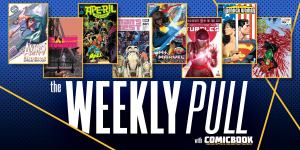Tomorrow, Image Comics will release the first issue of Infidel, a new horror series channeling the zeitgeist of anti-immigrant and anti-Muslim paranoia and the spirit of Get Out.
Videos by ComicBook.com
A haunted house story for the 21st century, Infidel follows an American Muslim woman and her multiracial neighbors who move into a building haunted by entities that feed off xenophobia. Bestselling editor Pornsak Pichetshote makes his comics-writing debut alongside artist Aaron Campbell, award-winning colorist and editor José Vilarrubia, and letterer/designer Jeff Powell.
Pichetchote, Campbell, and Villarrubia joined ComicBook.com to discuss the series, the first issue of which will be in stores tomorrow, and to share an exclusive look at the cover to Infidel #4, coming in June.
The tone of the book toggles back and forth between a fun, family story and some pretty grotesque horror. What motivates going to those extremes rather than picking a middle ground?
PORNSAK PICHETSHOTE: Infidel is a horror comic about an American Muslim woman and her multi-racial neighbors who all live in a building haunted by creatures that seemingly feed off xenophobia. So, what I’m hoping you get from that sense of fun and family is a feeling of warmth and camaraderie—which makes it all the more disruptive and disturbing when the horror finally does hit. After all, I think good horror should make you feel safe at some moments; it makes ripping it away from you when you least expect it all the more effective. My worry about a middle ground is that you lose that sense of contrast and in the process, one of the key tools of good horror.
JOSÉ VILLARRUBIA: Toggling between those extremes is actually what the best contemporary horror stories often do, especially when they deal with everyday life. I’m thinking of Rosemary’s Baby, The Shining, Don’t Look Now, and Psycho, which may be my favorite scary movies. They all have elements of humor…
Can you talk a little bit about the color palette of this comic? The opening looks and feels like nothing I have seen recently.
AARON CAMPBELL: Oh man, I’m so glad you caught that! It sort of proves my concept. The opening scene’s color palette is a bit of a collaboration between José and me. I had the idea that it might be interesting to fragment the color to ramp up the otherworldly nature of the sequence and suggest Aisha’s fracturing mental state. So, José handed over his amazing colors and let me go to town, slicing it to little geometric bits. If it didn’t achieve exactly what I was going for, at least it caught your attention.
VILLARRUBIA: The color palette for the comic is atmospheric, with a lot of desaturated colors and analogous schemes. It is fairly “realistic” to give the scenes a feeling of being grounded in a reality. The bold color is saved for the supernatural scenes. The original color effect in the opening sequence was actually created by Aaron himself, over my colors, with a little tweaking by me. This book is a true collaboration. As the editor, I give Pornsak and Aaron notes on the story, dialog, layouts, artwork, and covers. And Aaron and Pornsak give me notes on my coloring. I have to say we are all pretty picky!
How much communication was there between yourself and the art team re: the designs of some of the odder, scarier stuff?
PICHETSHOTE: The thing I love about this book is that we really are a team. All of us weigh in on what everyone else is doing. Aaron and José weigh in on script; I weigh in on art. We all have our two cents on design. Everyone has skin in this game. So, we were definitely all constantly talking about the scares and how they work. That said, though, the credit for the scares working definitely goes to Aaron and José. It doesn’t matter how many scary scenarios I throw into it, this book lives and dies by how scary things look. And Aaron knocked it out of the park.
CAMPBELL: The short answer is hours and hours, and hours and hours, and several more hours of convoluted, winding, tangled phone conversations. Ultimately, though, I took the foundational ideas that Pornsak and José had developed and ran rampant with them. I began with an image in my head and sort of reverse engineered them, trying to imagine how their wounds and physical form could suggest who they were in life. So, pay close attention as you read the series and see if you can riddle out aspects of their characters before the end.
VILLARRUBIA: From the concept to the style to the art tools to execution, we all contributed to what the horror scenes would look like… But as editor, I’m pushing Aaron to be as wild as he can! And then some more….
This is a photorealistic New York on the outside. What role does the city play in how things unfold between our characters?
PICHETSHOTE: I live in Los Angeles now, but I spent most of my adult life in New York City, so I self-identify as a New Yorker, to the point that it annoys the crap out of my LA friends. (Yeah, I’m that guy.) The thing that made New York the best setting for the story is that, not only is it a place the entire creative team has lived at one point or other, but it is a melting pot where different types of people are constantly in casual contact, and our story gains the most immediacy in that setting.
Plus, when talking about xenophobia, it’s easy to paint them as extremes, that it only exists in rural, flyover country. With Infidel, I was way more interested in talking about the bias that exist in multicultural communities that people consider super liberal and ask how open-minded we really are.
CAMPBELL: For me, it was all about the building. I went to grad school in New York and lived in a run-down pre-war fourth floor walk-up in Jackson Heights, Queens. For two years, I became deeply aware of how isolating that kind of environment can be and how bizarre and disconcerting the tiny glimpses of your neighbors tend to be. That was the building I wanted to design. And hopefully I captured just a bit of that tension.
How would you describe the series to a potential new reader?
PICHETSHOTE: In a nutshell, Infidel follows an American Muslim woman and her multi-racial neighbors who find themselves living in a building haunted by strange creatures that seem to feed on xenophobia. It’s our attempt to update the haunted house story as aggressively as possible, partly by having the world of the book reflect in the world we see outside our window. It tackles themes like xenophobia, Islamophobia, and racism—these seemingly omnipresent forces in our society while questioning if we understand them well enough to fight them. It’s all part of our hope to make a truly scary comic and update the haunted house genre as aggressively as we can.
CAMPBELL: I’d add one additional aspect to that. Not matter what you think it is, it won’t be anything like what you’re expecting.
Why in particular did you want your main character to be a woman of color?
PICHETSHOTE: I wanted to tell a story about xenophobia and racism, and it felt like if I wanted to really explore those issues in this time in history, it made sense to have a protagonist that was feeling the heaviest, most varied brunt of it, and to me, that’s a brown Muslim woman. And while the fact that experience hadn’t been explored a lot in fiction did make the character more appealing to me; once I made that decision, the responsibility to get the character right kicked in. And it kicked in hard. And that involved talking to a lot of friends as well as making some new ones who could help me use my experiences as an Asian-American man to help me empathize with a South Asian Muslim-American woman. And then finding the version of the character that’s based on my life and those of my friends, I can truly say with authority, OK, I know this character inside and out. And then after all that work, it’s praying I didn’t screw up. I can’t emphasize enough how integral praying I didn’t screw up is to this process.
Infidel #1 will be available in stores and online tomorrow.





